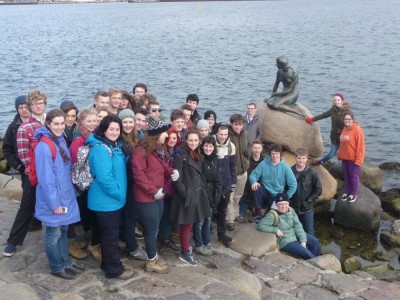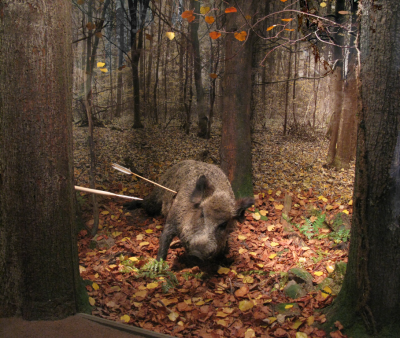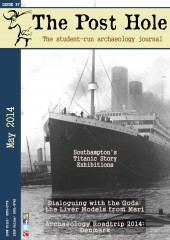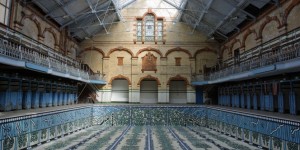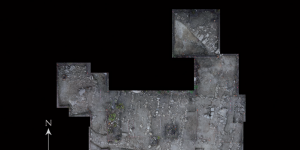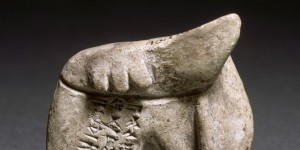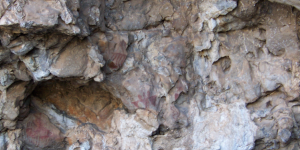Aidan Scott and I had considered Denmark as a destination for our annual Archaeology road-trip for several years, but had previously dismissed it on costs. We wanted all students to be able to access our trips and, as with much of Scandinavia, Denmark is not cheap. However, after some serious arm-twisting and weeks of logistical research, we finally found a way to visit Denmark. Sadly, this meant leaving our beloved minibuses behind due to the time and cost, and travelling by public transport instead. We had to go before Easter, which was not ideal considering that most of the open air museums (for which Denmark is famous) do not open until April or May. These include the experimental centre at Lerje (near Roskilde), Viking Fyrkat and Viking Ribe. A further blow was the complete rebuilding of the wonderful Moesgaard Museum just outside Aarhus which will not re-open until the end of 2014. This includes finds from the fascinating Mesolithic sites of Ringkloster and Tybrind Vig, the Illerup Hoard and Grauballe Man. Still, there was more than enough left to fill a full week.
Arriving in the late evening, we based ourselves at The Copenhagen Amager Danhostel. We purchased passes at the airport on arrival to get to Roskilde on our first full day. The main draw to Roskilde is the Viking ship museum. As it was winter, the reconstructed boats were drawn up on the grass, but that was interesting in itself. The contrast between the deep hulls of the traders and the long, sleek shapes of the warships was very evident. Inside the museum were the remains of five ships recovered from the Fjord, as well as displays on construction, trade and warfare. A film in English explained the excavation and reconstruction, while the boatyard outside provided insights into the use of wood, shipbuilding and early medieval technology. Aside from its stunning Cathedral (the Domkirke), Roskilde, in common with most large provincial towns, has its own museum. This presented a chronological summary of Denmark from the end of the Ice Age into the Medieval Period. We encountered the skeleton of an auroch, the wild cattle that once roamed the forests of northern Europe. A final bonus was a small keyhole excavation near the Cathedral which provided a good example for the students.
Day 2 was spent at the National Museum in Copenhagen. It is probably the best museum in the world if you are interested in the Mesolithic, and a day was not nearly enough. The first few galleries cover the first post-glacial reindeer hunters in Scandinavia and Maglemosian foragers from the early Mesolithic. Exhibits include bone and antler harpoons, hooks, axes and the skeleton of an elk. The exhibition is all labelled in English but you do need to know a bit about the period to really appreciate what you are seeing. Nevertheless, we gained a real insight into the sophistication of technology and the nature of the economy from this time. It provides a great contrast with the rather pitiful display in the British Museum of a couple of finds from Star Carr. Moving further into the Mesolithic, towards the final Ertebølle Culture from 5300-4000BC, a much wider range of artefacts are available. These include those made from organic materials such as wood, plant fibres and skins, which survive so well in Danish peat bogs and underwater in the Baltic shallows. The world’s oldest bow, woven fish-traps and canoe paddles are amongst the standout finds. Cut-marks on animal skulls demonstrated skinning while figurative and abstract engravings on antler, bone and amber testified to the rich cultural life of the Mesolithic.
Later galleries track the arrival and development of farming, metal working and ritual practice. It was particularly interesting to compare this with the knowledge students had from the British Isles. The human and artefact remains were highlights for most students, particularly the Gundestrup Cauldron and the’ Egtved Girl’. There is a particularly impressive gallery on ‘Sun worship’ during the Bronze Age. We also spent time in the early medieval galleries looking at the development of towns and trade, but also continuity and change in religious practice. Inevitably we ran out of time. I don’t think more than a handful of students got beyond the Vikings or upstairs to the excellent ethnographic collection of Inuit artefacts. These are interesting to students of the Mesolithic as sources of analogies for interpreting technology and ritual.
On Day 3 we took the train and bus to the Vedbaek Finds Museum. This was actually out in the countryside at Gl Holtegaard, a small stately home with a baroque garden. Anne, the curator, gave us a really interesting talk, a tour of the main finds and the areas of current research. The finds come from the shore of the Maglemose Fjord, and in particular, during excavations ahead of the construction of a school. We had all read about some of the burials from the Ertebolle cemetery but had not realised the extent of the midden deposits, which provided a rich source of information about diet and technology. The museum itself was designed in the 1970s to engage all senses in understanding the Mesolithic. Galleries are organised so you feel as if you are moving between the trees with some excellent dioramas depicting aspects of life around the Fjord. Many displays invite you to touch, and there are collections of different furs that enable you to appreciate the different properties of materials. Anne stressed that most visitors are kindergarten or primary classes, but our 17-18 year olds loved this aspect too. There was even a ‘smell tube’ so that you could experience the aroma of the midden. Artefacts and recreations are juxtaposed so that you can understand how things (leisters, bark containers) would have actually looked. The highpoint for most students, as ever, were the human remains. Several of the graves including the famous ‘Swan Wing’ burial were laid out so that you could look down into them and appreciate the care that had been taken with the corpses of over 6000 years ago. It provided a good contrast with the National Museum in terms of presentation.
Day 4 was largely spent in transit, moving from Copenhagen to Aarhus in Jutland. By the early afternoon, we had checked into our new home at Aarhus Danhostel, set in woodland to the north of the city. Then we went back into town in time to visit Viking Aros, which is an interesting piece of developer-led archaeology. Whilst building a new bank, houses from the Viking period were discovered. The bank has allowed finds to be displayed on the site in its basement. For our students who had visited Jorvik, it provided an exercise in ‘compare and contrast’, including many familiar aspects of housing, trade and manufacturing.
For Days 5 and 6, we ventured out into more remote areas. On Day 5, we headed for the Limfjord of Northern Jutland meeting Bjarne, the curator of the Vesthimmerland Museum on the way. He had kindly agreed to guide us and began by taking us to two amazing Neolithic tombs. Voldstedlund reminded us of Wayland’s Smithy – only better preserved and much bigger. It is about 25m long and up to 3m high with two remarkably intact chambers accessed by short passages. Both of these were large enough to stand in. Outside, kerbstones ran the length of the monument. A short drive away, and equally impressive, was the double-passage grave of Sniphøj. This is the best preserved of at least three passage graves. We were able to access both chambers.
Moving on to the Limfjord itself, we came to the most famous Mesolithic location of them all at Ertebølle. The Visitor Centre here is in a state of flux, having recently been taken over by Vesthimmerland Museum, and there are plans to radically rework the displays. Currently, they rely on re-constructions to supply an impression of Mesolithic life. A short walk away, a slight rise on the edge of the shore meadows is what remains of the great shell midden. As with most Danish sites, some good signage in three languages helped with interpretation of the area.
This is something we rarely achieve in the UK. It is a fabulous location. Even though the levels in the Limfjord have changed much over the millennia, it was still possible to understand why this had been such a favoured spot for foragers. Driving on up the Limfjord, we passed the remains of the Bjornholm Midden before arriving at Aggersund.
Our guide had been particularly keen for us to visit this, the largest of the Viking fortresses built by Harald Bluetooth. While the earthworks are not dramatic, the location certainly is. The site dominates what was once an inland water-route through Jutland and north-south land access. The sheltered anchorage of the Limfjord and the fort, which could also hold 4000 warriors, possibly has a link to our own history. If you sail west out of the Limfjord, your next landfall is England, which was where Bluetooth’s son Svein Forkbeard headed to claim a second crown after deposing his father. At Aggresund, we saw a number of metal detectorists in a nearby field. They are a group who work with the museum to plot finds, which are then added to maps of activity around this site. Further archaeological research is planned along the shore to try and identify the Viking era port.
Vesthimmerland Museum in Aars is close to the sites of many of the most famous bog-finds, including the Gundestrup Cauldron. The excellent local museum has a first-rate facsimile of the silver cauldron and displays of other artefacts which put it in context. Additional displays cover the archaeology of Jutland from the first hunters, but it is the Iron Age finds which really grab your attention here. The extensive collection includes many wooden artefacts from the bogs, including a cart, clothing and a leather shield. One of the most amazing is a Shaman’s bag looking exactly like a Doctor’s ‘Gladstone bag’. Also present are the finds from the fortified village of Borremose where we were headed next. This was accessed after a short walk through the bog. Although restored after excavation, the walls, foundations and atmospheric bog location still gave us a good insight into the nature of the settlement.
Day 6 was mid-Jutland with our first stop being the lakeside of Bølling Sø. This peat cutting area has recently been restored to a lake, and is one of the key locations in Danish Archaeology. Right at the end of the Palaeolithic it was visited by reindeer hunters, then was repeatedly used during the Maglemose Period with camps such as Klosterlund and hunting stands scattered along the shore, rather like the contemporary sites, including Star Carr, around Lake Pickering in Yorkshire. During the Bronze Age, wooden platforms had been used to deposit votive offerings in a similar manner to Flag Fen in Peterborough. On the far side of the lake were the find sites of a number of bog bodies including Tollund Man. In common with several Danish sites, the information panels featured QR codes enabling those with smartphones to pan across the landscape while getting a commentary about the archaeology.
Heading into Silkeborg, we visited the museum, which is now the home of Tollund Man. The museum itself was a little disappointing (although the recreations of Roman Armour and equipment were of interest to some), but Tollund Man alone is worth the trip. In a chamber behind a number of displays of Iron Age life, the preservation of his face is astounding even though you may have seen images of him dozens of times before. Many of our group said it was the highlight of the trip. However, there was more to come. A short drive through the Lake District, we came to Skanderborg and another provincial museum. This had two small, but fascinating displays of finds from Ringkloster (Mesolithic) and Illerup (Iron Age), both of which were excavated locally. The museum is currently excavating the exciting site of Alken Enge. This is a lakeside location where the butchered remains of a defeated army were brought and literally thrown into the water as part of a ritual. Originally it was thought that these might be the men whose equipment had been sacrificed at Illerup, but these were 200 years earlier in around 0AD. Ejvind Hertz, the curator, had set up a talk for us by Morten Rasmussen, a Biological Anthropologist who is working on the skeletal remains of the hundreds of warriors being slowly revealed. This was an amazing session, providing real insights into the work of a specialist, but also into what is being learned about the nature of Iron Age armies and the way in which this is transforming notions of social organisation at the time. This was a proper army, largely composed of physically large young men, although curiously, few bore the tell-tale signs of healed wounds from earlier conflicts.
Our final destination was Jelling, a key ‘place of power’ for the first Kings of Denmark. Within a huge enclosure, close to a number of Bronze Age barrows, two massive monuments were erected by Harald Bluetooth. One for his father Gorm, and one perhaps intended for himself, which was never used. We were joined by Charlotta Lindblom, curator of Vejle Museum, who gave us a talk about the archaeology and the significance of the site. She was able to describe finds associated with the massive lines of oak posts and the Viking-era hall which predated the first Christian church in Denmark. The site is also famous for the two massive runestones erected by Harald Bluetooth describing his unification of Denmark and conquest of Norway. It seemed a fitting place to end our trip.
Our final day involved a return by coach, this time via catamaran across the Kattegat, complete with dolphin spotting opportunities, and then direct to Copenhagen Airport. This was our most logistically complex trip ever, but everything worked like clockwork and we encountered incredible generosity from staff at the museums, to whom we are really grateful. For anyone interested in prehistory, Denmark is a great destination, but for those interested in the Iron Age/Viking period, and particularly the Mesolithic, it is a must.


